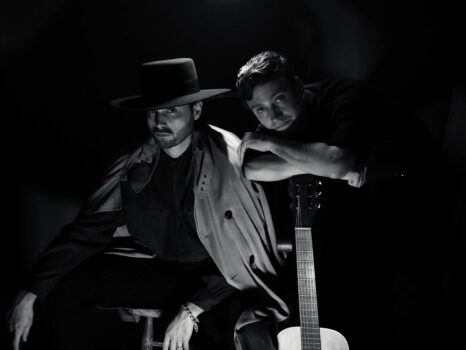
.........................................................
Ruen Brothers create neo-noir Western gold with their upcoming album Ten Paces, their third full-length and first on Yep Roc Records.
“We aimed to create something cinematic and personal, an album that takes listeners out of their world and into the West, like Marty Robbins’ Gunfighter Ballads and Trail Songs does,” says Rupert.
A Western record may seem out-of-place for two British brothers (Rupert and Henry Stansall) raised thousands of miles from the desert landscape from which they draw. However, their hometown of Scunthorpe, England offers more similarities than you might expect.
An industrial steel town, Scunthorpe sits amid the vast farmlands of Northeast England. “We tended to horses and often got stuck behind a tractor on the way to school,” recalls Henry. “Mum would play American western films as Rupert fingerpicked a nylon string guitar and I practiced my Howard Keel impersonation,” he laughs.
This upbringing gave them the confidence to embrace their love of the genre through this album, having first hand knowledge of saddling up, strumming guitars and spending hours and hours in fields, bars and barns in the middle of nowhere.
The experiences combine with the Brothers’ technical prowess – Rupert is a classically trained guitarist; Henry, a choir-trained tenor with a dynamic four-octave range – to create a tour-de-force album that both glorifies and modernizes the Western genre.
In addition to ten spectacular tracks, Ruen Brothers have created slick, noir-esque images and videos inspired by mid-century films like The Night of the Hunter to further immerse the audience in their romantic, haunting vision.
Ten Paces was also produced by Rupert, who developed the skill after receiving a four-track cassette recorder on his tenth birthday. He’s helmed many Ruen Brothers singles to date, including their first UK radio hit “Aces,” and their 2021 album ULTRAMODERN. Ten Paces further showcases his astounding technical ability as he deftly manages to preserve the quality and authenticity of early recording gear and techniques, while achieving a uniquely modern sound.
More still, Ruen Brothers had the hurdle of writing and recording Ten Paces while living on opposite coasts. Rupert would craft the base of the recordings from Los Angeles then send them to Henry to lay down acoustic guitar and vocals in Brooklyn.
Henry often recorded hundreds of vocal takes to get the delivery and emotion just right for each song. “My approach to the vocal delivery on Ten Paces differs from that of previous records,” Henry shares. “I sang much of the album in a lower octave register than usual to create a grounded and conversational feel, true to the laconic, hard boiled characters of the West.” This lower register – apparent in upcoming single “The Fear” – also reflects his years of covering Johnny Cash songs in their British pub days.
Another vocal method Henry used in Ten Paces was “jumping between octaves” in songs where emotions are highest. His love for Orbison and extensive training helped him achieve that balance of power and delicacy in ballads like “Bullet Blues” and “The Good Surely Die.”
Because of their separation, Ruen Brothers slightly adapted their approach to songwriting. Some songs Rupert created entirely before they were revised via telephone calls with Henry, and vice-versa. “The Fear,” “Don’t Know What’s Come Over You,” “Slow Draw” and “Silver to Gold” are examples of this. Overall this process allowed them to generate a lot of new material quickly and their joint revision process created the album’s consistency in tone.
Similarly to their previous two albums, Ten Paces showcases Ruen Brothers’ wide range of songwriting ability and profound knowledge of the musical influences from which they pull.
Fans of “All My Shades of Blue” will recognize the soaring chorus of “Bullet Blues;” those who love “The Storm In You” and “Summer Sun” may lean into the alt-tinged tracks “Slow Draw” and “The Good Surely Die;” fans of the country train beat track “Walk Like a Man” won’t be able to resist the toe tapping “Silver to Gold” and “Hi-Yo.”
One production aspect that Ten Paces expands on from their previous albums is their use of sound effects such as the ricochets and thunder heard in “Slow Draw” and “The Fear.” On some tracks, canyon-sized reverbs expand the aural environment. On others, reverbs that mimic small wooden rooms confine the space.
Unusual instruments like theremin and saw add nuance and emotion. “Those instruments glide and wail between notes like the human voice,” says Rupert. Electric guitars pushed through vintage tape machines give an unsettled, tactile feel; wobbling the pitch like a burnt-out old record player.
Much of this sonic ingenuity was born from a turbulent period of bad luck and good fortune. After the pandemic canceled their live music gigs – including a promising tour with rising alt-country star Orville Peck – the duo turned to writing music for film. Since 2020, they’ve penned songs for films like Blumhouse’s Adopt a Highway, Netflix’s award-winning rom-com The Half of It, and even a full score for the indie feature Going Nowhere.
Rupert describes how there’s “commonly a void between songs, score and sound design. We wanted to take some steps toward merging them with this album”.
Furthering their idea of creating an immersive soundscape, the album’s cover art features a blood red crescent moon above a cactus and eagle – an ode to Rupert’s dusky evening strolls through Moon Canyon in Los Angeles – to instantly place the audience in the right setting.
For “The Fear” music video, Ruen Brothers created a wooden cabin set in their Los Angeles studio. A seemingly incongruous teddy bear also appears in the video to create an unnerving surrealism and hint of vulnerability in the seemingly rugged characters.
The video uses an old-fashioned and unusual 1.19:1 ratio to bring out the claustrophobic and anxiety driven nature of the lyrics which were initially inspired by the flooding of Henry’s basement recording studio during Hurricane Ida.
The Brothers had a similarly unique approach to capturing the light. “We saw a difference between modern black and white footage and early 20th century black and white footage. After some research we realized early film couldn’t capture red light, so we filtered it out using green and blue lenses for that same orthochromatic look,” Rupert explains. This technique tends to make skin tones darker and more uneven, which creates a slightly sinister atmosphere.
“We shot it using very low exposure, which meant introducing a lot of light to the sets. It achieved a high quality image with detailed shades that preserved the details and texture of our black clothes, body language and performances,” Rupert continues.
“Initially, it was surprisingly hard to avoid looking like lumps of black-clad flatness. My black hat could easily blend into the background leaving mostly my teeth and eyes peering through the darkness at the camera,” Henry remembers.
They were happy that much of the video footage ended up looking like moving versions of noir photos. The slow motion, used in “Slow Draw”’s music video, makes the footage a strange hybrid between new and old. “Slow motion wasn’t possible in the early part of the 20th century but it created some great effects, like beautifully slow evolving swirls of smoke and a smoothness and clarity we don’t see in old footage,” says Rupert. For everything else they shot at 24fps, the standard for cinema.
Shooting wasn’t without its upsets from piercingly bright lit sets that turned pitch black when the pause button was hit, to the air-con failing midway though the week-long session. “It was in LA in August and we were fully dressed in trousers and thick faux suede shirts. Still, they didn’t have air con in those big movie studios during the early days, so maybe it made us look a little more ‘the part’,” laughs Henry.
The Brothers’ all black attire took some influence from their year-long residency at NYC’s McKittrick Hotel (home of famed Off-Broadway show ‘Sleep No More’) as that was the dress code for the Art Deco, 1930s-style ‘Manderley Bar’ where they performed.
The starkly lit visuals, cinematic references, and torments of trying to achieve quality under tough conditions call back to their “Aces” music video which they made with an iPhone 4 and a clip light in their tiny London apartment.
“Aces” became a BBC Introducing Track of the Week, and garnered back-to-back radio spins from Zane Lowe, exposing the Brothers to a national audience and lots of new fans. Soon after they worked with legendary producer Rick Rubin on their debut album All My Shades of Blue (Ramseur/Universal).
“I liked that their songwriting seemed like it was from another era, making something new again with these traditional influences,” Rick Rubin has said.
First learning to play music from their dad’s vintage record collection – Charlie Feathers, Johnny Cash, Roy Orbison, Chuck Berry and The Everly Brothers – by 12 and 13, Rupert and Henry (as they were then known around town) were performing in the smoke-laced working mens pubs of Northern England. Local farmers and steel workers would drunkenly dance, often fight, and usually call out to hear those old-timey American hits.
They’d play every gig from barn weddings to bar funerals. They never had much money, and no one in the town really did either, so “150 pounds from a landlord was a very tempting offer that brought [them] out to play in all weather, usually rain,” jokes Henry.
It was this older-than-their-years childhood that honed the decisiveness and professionalism that streamlined their album’s creative journey. “If it didn’t work, we wouldn’t keep it. We weren’t precious about ideas, each song and idea was simply, ‘do we like it or not,’ similarly to how the pub-goers would judge us on stage,” tells Rupert.
On that note, Ruen Brothers hope the album takes them ten paces closer to people who yearn for uniquity, quality and, above all, great songs.
On Tour:
Media:
Links:
Yep Roc Discography:

